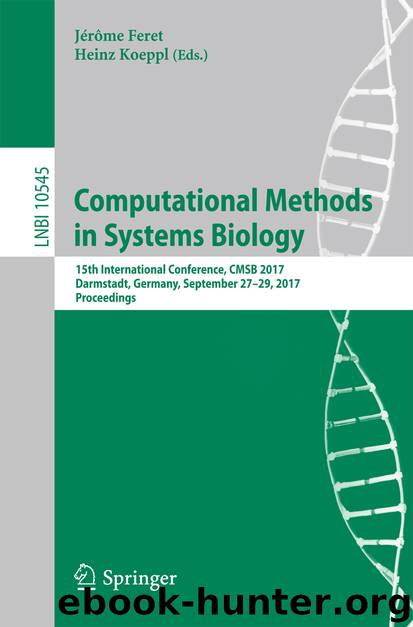Computational Methods in Systems Biology by Jérôme Feret & Heinz Koeppl

Author:Jérôme Feret & Heinz Koeppl
Language: eng
Format: epub
Publisher: Springer International Publishing, Cham
Keywords
DNA methylationHidden Markov modelSpatial stochastic model
1 Introduction
The DNA code of an organism determines its appearance and behavior by encoding protein sequences. In addition, there is a multitude of additional mechanisms to control and regulate the ways in which the DNA is packed and processed in the cell and thus determine the fate of a cell. One of these mechanisms in cells is DNA methylation, which is an epigenetic modification that occurs at the cytosine (C) bases of eukaryotic DNA. Cytosines are converted to 5-methylcytosine (5mC) by DNA methyltransferase (Dnmt) enzymes. The neighboring nucleotide of a methylated cytosine is usually guanine (G) and together with the GC-pair on the opposite strand, a common pattern is that two methylated cytosines are located diagonally to each other on opposing DNA strands. DNA methylation at CpG dinucleotides is known to control and mediate gene expression and is therefore essential for cell differentiation and embryonic development. In human somatic cells, approximately 70–80% of the cytosine nucleotides in CpG dyads are methylated on both strands and methylation near gene promoters varies considerably depending on the cell type. Methylation of promoters often correlates with low or no transcription [20] and can be used as a predictor of gene expression [12]. Also significant differences in overall and specific methylation levels exist between different tissue types and between normal cells and cancer cells from the same tissue. However, the exact mechanism which leads to a methylation of a specific CpG and the formation of distinct methylation patterns at certain genomic regions is still not fully understood. Recently proposed measurement techniques based on hairpin bisulfite sequencing (BS-seq) allow to determine on both DNA strands the level of 5mC at individual CpGs dyads [15]. Based on a small hidden Markov model, the probabilities of the different states of a CpG can be accurately estimated (assuming that enough samples per CpG are provided) [1, 13].
Mechanistic models for the activity of the different Dnmts usually distinguish de novo activities, i.e., adding methyl groups at cytosines independent of the methylation state of the opposite strand, and maintenance activities, which refers to the copying of methylation from an existing DNA strand to its newly synthesized partner (containing no methylation) after replication [10, 17]. Hence, maintenance methylation is responsible for re-establishment of the same DNA methylation pattern before and after cell replication. A common hypothesis is that the copying of DNA methylation patterns after replication is performed by Dnmt1, an enzyme that shows a preference for hemimethylated CpG sites (only one strand is methylated) as they appear after DNA replication. Moreover, studies have shown that Dnmt1 is highly processive and able to methylate long sequences of hemimethylated CpGs without dissociation from the target DNA strand [10]. However, an exact transmission of the methylation information to the next cellular generation is not guaranteed. The enzymes Dnmt3a and Dnmt3b show equal activities on hemi- and unmethylated DNA and are mainly responsible for de novo methylation, i.e., methylation without any specific preference for the current state of the CpG (hemi- or unmethylated) [17].
Download
This site does not store any files on its server. We only index and link to content provided by other sites. Please contact the content providers to delete copyright contents if any and email us, we'll remove relevant links or contents immediately.
Algorithms of the Intelligent Web by Haralambos Marmanis;Dmitry Babenko(8522)
Test-Driven Development with Java by Alan Mellor(7407)
Data Augmentation with Python by Duc Haba(7301)
Principles of Data Fabric by Sonia Mezzetta(7049)
Learn Blender Simulations the Right Way by Stephen Pearson(6986)
Microservices with Spring Boot 3 and Spring Cloud by Magnus Larsson(6807)
RPA Solution Architect's Handbook by Sachin Sahgal(6219)
Hadoop in Practice by Alex Holmes(6031)
The Infinite Retina by Robert Scoble Irena Cronin(5918)
Jquery UI in Action : Master the concepts Of Jquery UI: A Step By Step Approach by ANMOL GOYAL(5873)
Big Data Analysis with Python by Ivan Marin(5721)
Life 3.0: Being Human in the Age of Artificial Intelligence by Tegmark Max(5403)
Pretrain Vision and Large Language Models in Python by Emily Webber(4684)
Infrastructure as Code for Beginners by Russ McKendrick(4464)
WordPress Plugin Development Cookbook by Yannick Lefebvre(4195)
Functional Programming in JavaScript by Mantyla Dan(4124)
The Age of Surveillance Capitalism by Shoshana Zuboff(4116)
Embracing Microservices Design by Ovais Mehboob Ahmed Khan Nabil Siddiqui and Timothy Oleson(3982)
Applied Machine Learning for Healthcare and Life Sciences Using AWS by Ujjwal Ratan(3959)
